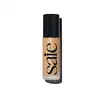Saie Glowy Super Skin Tint Foundation Versus Fenty Beauty Pro Filt’r Soft Matte Longwear Liquid Foundation
What's inside
What's inside
 Key Ingredients
Key Ingredients

 Benefits
Benefits

 Concerns
Concerns

 Ingredients Side-by-side
Ingredients Side-by-side

Water
Skin ConditioningDicaprylyl Carbonate
EmollientDicaprylyl Ether
EmollientTrioctyldodecyl Citrate
EmollientGlycerin
HumectantPolyglyceryl-6 Polyricinoleate
EmulsifyingPolyglyceryl-6 Polyhydroxystearate
EmulsifyingPolyester-7
Skin ConditioningMica
Cosmetic ColorantNeopentyl Glycol Diheptanoate
EmollientSqualane
EmollientSodium Chloride
MaskingSodium Hyaluronate
HumectantPolyglutamic Acid
Skin ConditioningPhyllanthus Emblica Fruit Extract
HumectantAlthaea Officinalis Root Extract
Skin ConditioningOryza Sativa Bran Extract
Skin ConditioningMagnesium Stearate
Cosmetic ColorantGlyceryl Caprylate
EmollientTrihydroxystearin
Skin ConditioningPolyglycerin-6
HumectantTriethoxycaprylylsilane
Caprylhydroxamic Acid
Stearic Acid
CleansingTocopherol
AntioxidantAscorbyl Palmitate
AntioxidantSodium Benzoate
MaskingPotassium Sorbate
PreservativeIron Oxides
CI 77891
Cosmetic ColorantCI 77492
Cosmetic ColorantCI 77499
Cosmetic ColorantWater, Dicaprylyl Carbonate, Dicaprylyl Ether, Trioctyldodecyl Citrate, Glycerin, Polyglyceryl-6 Polyricinoleate, Polyglyceryl-6 Polyhydroxystearate, Polyester-7, Mica, Neopentyl Glycol Diheptanoate, Squalane, Sodium Chloride, Sodium Hyaluronate, Polyglutamic Acid, Phyllanthus Emblica Fruit Extract, Althaea Officinalis Root Extract, Oryza Sativa Bran Extract, Magnesium Stearate, Glyceryl Caprylate, Trihydroxystearin, Polyglycerin-6, Triethoxycaprylylsilane, Caprylhydroxamic Acid, Stearic Acid, Tocopherol, Ascorbyl Palmitate, Sodium Benzoate, Potassium Sorbate, Iron Oxides, CI 77891, CI 77492, CI 77499
Water
Skin ConditioningDimethicone
EmollientTalc
AbrasivePEG-10 Dimethicone
Skin ConditioningTrimethylsiloxysilicate
EmollientPolypropylene
Isododecane
EmollientCetyl PEG/PPG-10/1 Dimethicone
EmulsifyingNylon-12
Hdi/Trimethylol Hexyllactone Crosspolymer
Phenoxyethanol
PreservativeSodium Chloride
MaskingHydrogen Dimethicone
Glycerin
HumectantMagnesium Sulfate
Sodium Dehydroacetate
PreservativeDisteardimonium Hectorite
StabilisingAluminum Hydroxide
EmollientMethicone
EmollientBenzoic Acid
MaskingDehydroacetic Acid
PreservativePropylene Carbonate
SolventEthylhexylglycerin
Skin ConditioningParfum
MaskingSilica
AbrasiveBiosaccharide Gum-4
Skin ConditioningAnanas Sativus Fruit Extract
Skin ConditioningCarica Papaya Fruit Extract
Skin ConditioningPaullinia Cupana Seed Extract
Skin ConditioningPotassium Sorbate
PreservativeSorbic Acid
PreservativeWater, Dimethicone, Talc, PEG-10 Dimethicone, Trimethylsiloxysilicate, Polypropylene, Isododecane, Cetyl PEG/PPG-10/1 Dimethicone, Nylon-12, Hdi/Trimethylol Hexyllactone Crosspolymer, Phenoxyethanol, Sodium Chloride, Hydrogen Dimethicone, Glycerin, Magnesium Sulfate, Sodium Dehydroacetate, Disteardimonium Hectorite, Aluminum Hydroxide, Methicone, Benzoic Acid, Dehydroacetic Acid, Propylene Carbonate, Ethylhexylglycerin, Parfum, Silica, Biosaccharide Gum-4, Ananas Sativus Fruit Extract, Carica Papaya Fruit Extract, Paullinia Cupana Seed Extract, Potassium Sorbate, Sorbic Acid
 Reviews
Reviews

Ingredients Explained
These ingredients are found in both products.
Ingredients higher up in an ingredient list are typically present in a larger amount.
Glycerin is already naturally found in your skin. It helps moisturize and protect your skin.
A study from 2016 found glycerin to be more effective as a humectant than AHAs and hyaluronic acid.
As a humectant, it helps the skin stay hydrated by pulling moisture to your skin. The low molecular weight of glycerin allows it to pull moisture into the deeper layers of your skin.
Hydrated skin improves your skin barrier; Your skin barrier helps protect against irritants and bacteria.
Glycerin has also been found to have antimicrobial and antiviral properties. Due to these properties, glycerin is often used in wound and burn treatments.
In cosmetics, glycerin is usually derived from plants such as soybean or palm. However, it can also be sourced from animals, such as tallow or animal fat.
This ingredient is organic, colorless, odorless, and non-toxic.
Glycerin is the name for this ingredient in American English. British English uses Glycerol/Glycerine.
Learn more about GlycerinPotassium Sorbate is a preservative used to prevent yeast and mold in products. It is commonly found in both cosmetic and food products.
This ingredient comes from potassium salt derived from sorbic acid. Sorbic acid is a natural antibiotic and effective against fungus.
Both potassium sorbate and sorbic acid can be found in baked goods, cheeses, dried meats, dried fruit, ice cream, pickles, wine, yogurt, and more.
You'll often find this ingredient used with other preservatives.
Learn more about Potassium SorbateChances are, you eat sodium chloride every day. Sodium Chloride is also known as table salt.
This ingredient has many purposes in skincare: thickener, emulsifier, and exfoliator.
You'll most likely find this ingredient in cleansers where it is used to create a gel-like texture. As an emulsifier, it also prevents ingredients from separating.
There is much debate on whether this ingredient is comedogenic. The short answer - comedogenic ratings don't tell the whole story. Learn more about comegodenic ratings here.
The concensus about this ingredient causing acne seems to be divided. Research is needed to understand if this ingredient does cause acne.
Scrubs may use salt as the primary exfoliating ingredient.
Learn more about Sodium ChlorideWater. It's the most common cosmetic ingredient of all. You'll usually see it at the top of ingredient lists, meaning that it makes up the largest part of the product.
So why is it so popular? Water most often acts as a solvent - this means that it helps dissolve other ingredients into the formulation.
You'll also recognize water as that liquid we all need to stay alive. If you see this, drink a glass of water. Stay hydrated!
Learn more about Water